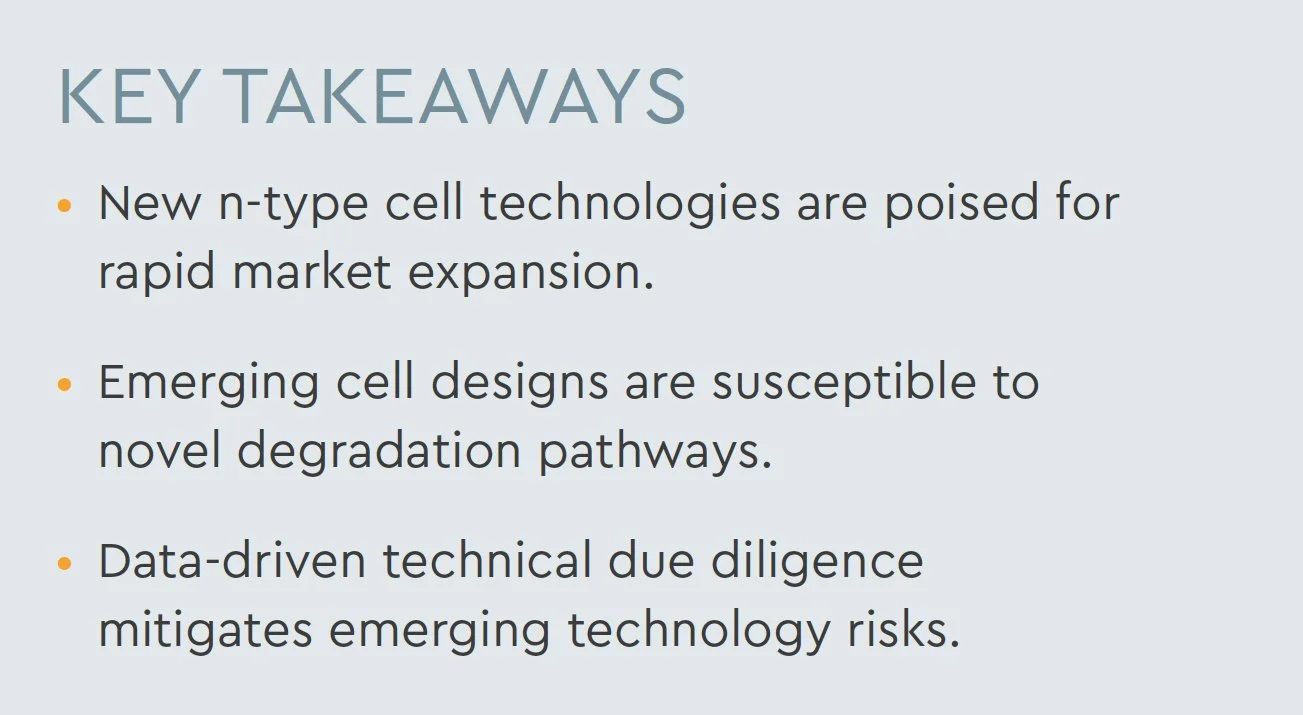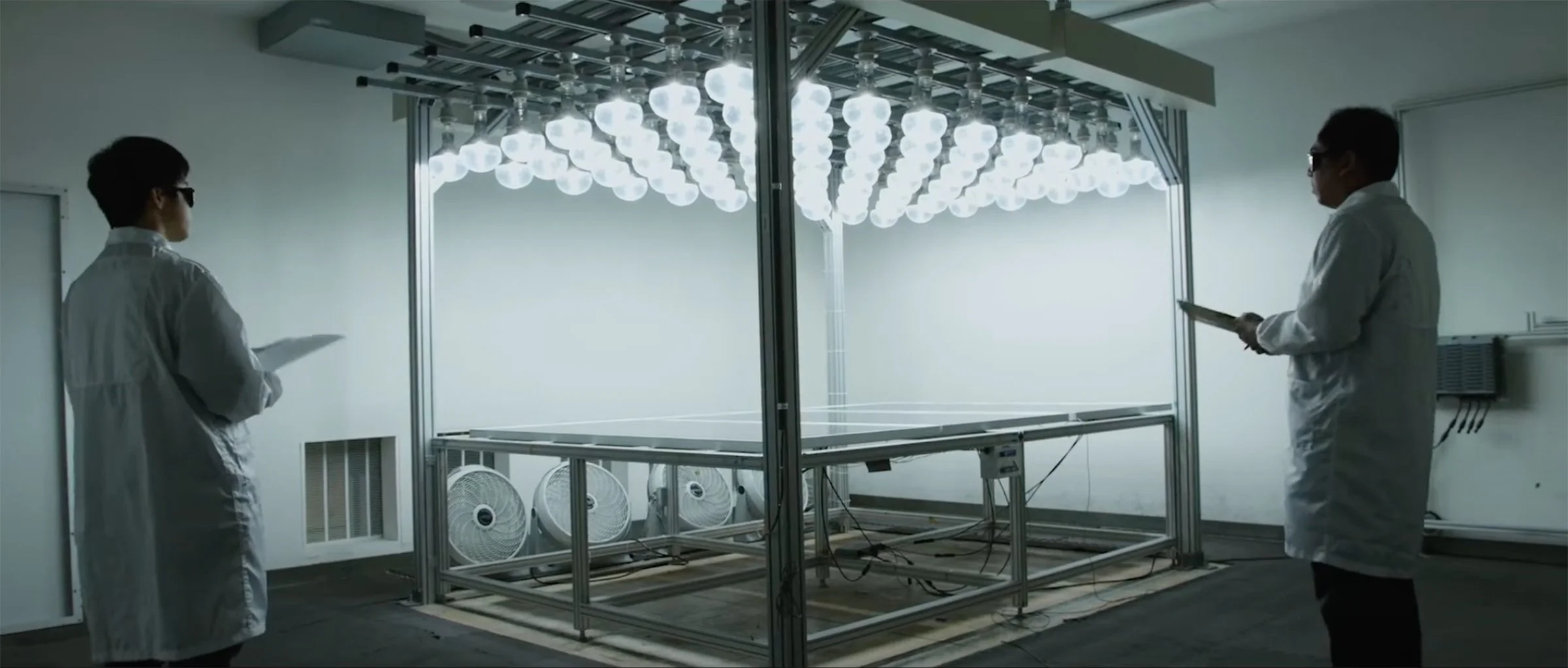Evaluating New N-Type PV Modules
Next-generation n-type PV cells are essential to the solar industry’s continued ability to drive down costs while improving performance.
In 2022, RETC is closely monitoring a technology trend quickly gaining market traction and acceptance: the rise of next-generation n-type PV cells with passivating contacts. Here, we explore the promise of new n-type PV cell designs—and the potential challenges associated with scaling this promising technology.
RISE OF TOPCON
Many industry analysts and material scientists believe emerging n-type PV cell designs are the next logical progression on the PV technology roadmap. In 2013, researchers at Germany’s Fraunhofer Institute for Solar Energy Systems presented a method of producing high-efficiency n-type silicon solar cells with a novel tunnel oxide passivated contact (TOPCon) structure. This novel cell design achieved high marks for open-circuit voltage (Voc), fill factor and efficiency thanks to excellent surface passivation and effective carrier transport.
Less than a decade later, TOPCon is the buzziest word in solar. The largest module manufacturers in the world are beginning volume production of PV modules with TOPCon cells. While LONGi Solar is betting big on p-type TOPCon, many other leading module companies—such as Jinko Solar, Jollywood Solar Technology, JA Solar and Trina Solar—are making substantial investments in modules with n-type TOPCon cell designs.
This collective pivot in the market is primarily due to flattening efficiency curves for the p-type passivated emitter and rear-contact cell (PERC) modules. Although these have dominated the market in recent years, manufacturers are starting to reach the physical limits of p-type mono PERC cell designs. Transitioning to n-type TOPCon cells will allow module companies to boost cell efficiencies further in the laboratory and mass production.
“Everybody wants the highest possible module nameplate rating,” explains Kenneth Sauer, principal engineer at VDE Americas. “Via higher open-circuit voltage values, you can achieve higher efficiencies and power ratings. In and of itself, that will likely move manufacturers to n-type TOPCon cell designs, as soon as they can get there.”
Comparison of p-type PERC and n-type TOPCon silicon cell designs.
BENEFITS OF N-TYPE CELLS
Solar manufacturers have long recognized the potential efficiency benefits of n-type PV cells. For example, Sanyo began developing n-type heterojunction technology (HJT) PV cells in the 1980s. In addition, SunPower has built its interdigitated back contact (IBC) PV cells upon a base of high-purity n-type silicon.
Due to the manufacturing complexities involved, high-efficiency PV modules based on n-type HJT and IBC cell designs are relatively expensive to produce and remain a niche part of the market. By comparison, n-type TOPCon cell manufacturing is similar to the PERC process. As a result, manufacturers can produce these next-generation high-efficiency TOPCon modules on upgraded PERC production lines.
Though today’s n-type TOPCon modules cost slightly more to produce on a per-watt basis than p-type mono PERC modules, the efficiency gains result in a lower levelized cost of energy (LCOE) in large-scale field deployments. Best of all, leading experts expect n-type TOPCon to benefit from an accelerated learning curve.
A primary material advantage of n-type TOPCon cells relative to p-type mono PERC cells is a lower degradation rate due to a decreased susceptibility to both light-induced degradation (LID) and light- and elevated temperature–induced degradation (LeTID). Additional advantages may include a higher bifaciality factor, as well as improved performance under both low-light and high-temperature conditions.
Flash testing in progress at RETC’s accredited independent testing laboratory.
RISKS OF EARLY ADOPTION
Most analysts expect modules with n-type TOPCon cells to quickly increase market share based on these performance advantages. However, emerging PV cell technologies—even ones that ultimately prove successful in the field—invariably carry more risk than mature and proven technologies. Until industry stakeholder have deployed products at scale, the potential exists for as-yet-undiscovered degradation mechanisms.
Today, for example, independent engineers and financiers consider p-type mono PERC PV modules a stable and low-risk technology. This assessment was not always a consensus opinion. Early versions of mono PERC modules had issues with stability, especially LID and, in rare instances, LeTID. These unexpected mono PERC degradation modes demonstrate the performance risks that early adopters face with new technologies.
While n-type TOPCon PV cells have proven resilient to LID and LeTID, some evidence exists of susceptibility to ultraviolet-induced degradation (UVID). For example, researchers at the SLAC National Accelerator Laboratory and the National Renewable Energy Laboratory (NREL) have documented front- and back-side power loss in advanced solar cell technologies after artificially accelerated UV exposure testing. These data do not point to a single degradation mechanism but suggest that different cell designs degrade via different pathways.
CASE-BY-CASE ASSESSMENT
Though it is impossible to eliminate all risk and uncertainty associated with technological innovation, artificially accelerated exposure tests—such as those conducted at RETC’s accredited laboratories—are a proven method of identifying novel failure and wearout mechanisms. Beyond-qualification and bankability test sequences and protocols are clearly valuable to manufacturers bringing new products to market. They are also critically important to developers, financiers and independent engineers seeking to de-risk early deployments of next-generation technologies.
“As someone who provides technical advisory services,” says Sauer at VDE Americas, “I recommend conducting accelerated UVID testing for new n-type modules as part of a technical due diligence survey. If cell passivation layers are not properly tuned, they can break down with UV exposure. Given all of the new cell designs coming to market, it is important to evaluate each one individually on a case-by-case basis.”
Given the high stakes involved, RETC is independently subjecting a variety of next-generation modules with advanced n-type cell designs to highly accelerated UV testing. “We’re not trying to sound an alarm for no reason,” explains CEO Cherif Kedir. “We just want to test the potential for UV degradation to educate ourselves and the industry. If there’s no problem, we can all move forward with our lives. If there is a problem, we will publish a report so that the industry can get out in front of the issue.”
For more information see:
RETC’s 2022 PV Module Index Report





